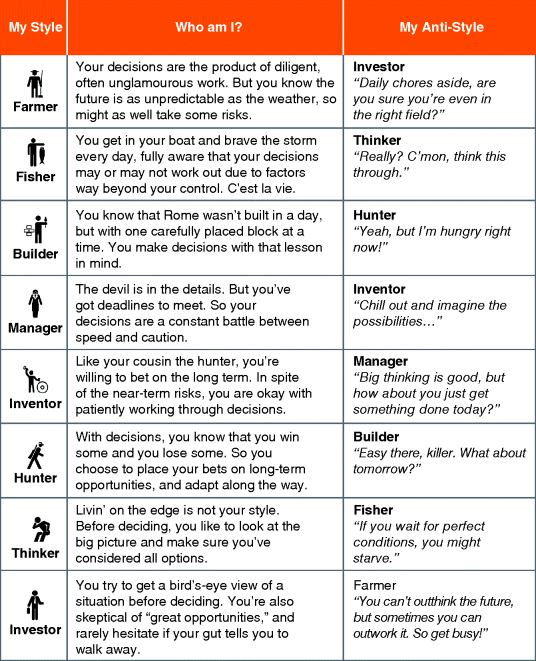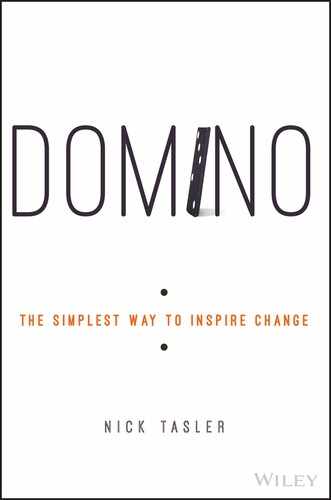14
Why Drivers Need Navigators
When making decisions, opposites attract…or at least they should. Let's face it, we all have blind spots. The only way to beat your blind spot is to find somebody who lives there (your anti-style) and buddy up with them when you need to make a decision. This frenemy is your secret weapon for smarter decisions.
An anti-you can be anybody who thinks differently than you. We need those people close by.
Why?
It's not just because somebody has to be there to annoy us when our families aren't around. We also need them to keep us from driving off the road, from causing accidents, and accidentally ditching the team members who are trying to follow us. Sometimes your anti-you is more or less assigned to you by your functional roles. In hospitals, doctors have nurses and nurses have doctors. Surgeons have anesthesiologists. Entrepreneurs have chief financial officers. Chris Albrecht from HBO had Carolyn Strauss. Glen Peterson from Davis Medical had Priya. Jorgen Knudstorp had Jesper Ovesen. Ruth Handler had her husband and Yas Yashida.
But in some cases, functional roles don't shake out the way you'd expect. About a year into the working relationship with my Chief Operations Officer, Cliff, we discovered just such a disconnect. After hearing me give a presentation on the importance of an anti-you in which I told the Mattel story from the previous chapter, he asked me afterward, “So am I supposed to be the risk-averse one in this relationship?”
Oops.
Although Cliff was playing the part of my CFO at the time, he had worked with a lot of entrepreneurs over the years and wasn't terribly risk-averse by nature. I had ignorantly assumed that just because he was considerably more experienced than me, and because I asked him to play the role of part-time CFO, that he would automatically be the cautious pessimist who would rein in my visionary tendencies. (And by “visionary” what I really mean, of course, is “irresponsible, scattered, and spacey.”) While functional roles and other superficial characteristics are usually a good starting point for identifying your anti-you, just be wary of overgeneralizing.
A better way is to use your decision style. Remember what your decision style was? Take a look at Figure 14.1 to find out who to look for to be your anti-style. Then get into the habit of consulting with that person, or someone like that person, when you're making decisions.

Figure 14.1 Anti-Styles
You can think of this anti-style as your navigator—and, yes, occasionally your backseat driver. Navigators help you drive better in two ways. They help you make smarter turns ahead, and can also look behind to make sure everyone else is still following you.
The driver already has plenty to think about just keeping an eye on the road ahead and anticipating what's coming next. The navigator has a different vantage point and often a different set of responsibilities. For example, as the entrepreneur at her company, Ruth Handler's job was to spot opportunities and keep pushing to realize her vision. She was focused on the future. As chief financial officer, Yas Yashida's responsibility was to keep the company financially healthy. This healthy tension is what allowed the company to keep plowing ahead without running out of gas. It also allowed Ruth to feel more confident in her decisions, knowing that Yas was mindful of her inherent blind spots as a reward-seeking entrepreneur.
In other cases, the navigator can help keep a closer eye on the train of cars following you. At Davis Medical, that was the role Priya played for Glen Peterson. Drivers also have a responsibility to check the rearview mirror, but Glen Peterson had to devote most of his attention on the path ahead so that he didn't cause the whole caravan to careen off the road. Priya's position in the division gave her a clearer view of where the rest of the team was at that time. She further leveraged that vantage point by consulting with her own direct reports to check their view of the new plan. She was able to call attention to a part of the trip that Glen hadn't noticed—namely that the rest of the team didn't notice him turn on his blinker.
Finally, after you check your pulse and consult your anti-you, there is just one thing left to do: decide.
This last step of actually grabbing hold of the wheel and making the turn is as much an act of faith as it is a logical calculation. Achieving clarity about your pulse and diligently covering your bases by consulting with one or more anti-yous should give you more confidence in the eventual decision. But the real world—the place that exists outside case studies, textbooks, and laboratory experiments—will always be one part unpredictable and one part unknowable. That's why, in the real world, real leaders simply have to make tough calls. Everyone is capable of making those calls, but it sometimes requires summoning the most courageous version of ourselves. So how do we do that?
